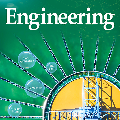SNNs are an active research domain towards energy efficient machine intelligence. Compared to conventional ANNs, SNNs use temporal spike data and bio-plausible neuronal activation functions such as Leaky-Integrate Fire/Integrate Fire (LIF/IF) for data processing. However, SNNs incur significant dot-product operations causing high memory and computation overhead in standard von-Neumann computing platforms. Today, In-Memory Computing (IMC) architectures have been proposed to alleviate the "memory-wall bottleneck" prevalent in von-Neumann architectures. Although recent works have proposed IMC-based SNN hardware accelerators, the following have been overlooked- 1) the adverse effects of crossbar non-ideality on SNN performance due to repeated analog dot-product operations over multiple time-steps, 2) hardware overheads of essential SNN-specific components such as the LIF/IF and data communication modules. To this end, we propose SpikeSim, a tool that can perform realistic performance, energy, latency and area evaluation of IMC-mapped SNNs. SpikeSim consists of a practical monolithic IMC architecture called SpikeFlow for mapping SNNs. Additionally, the non-ideality computation engine (NICE) and energy-latency-area (ELA) engine performs hardware-realistic evaluation of SpikeFlow-mapped SNNs. Based on 65nm CMOS implementation and experiments on CIFAR10, CIFAR100 and TinyImagenet datasets, we find that the LIF/IF neuronal module has significant area contribution (>11% of the total hardware area). We propose SNN topological modifications leading to 1.24x and 10x reduction in the neuronal module's area and the overall energy-delay-product value, respectively. Furthermore, in this work, we perform a holistic comparison between IMC implemented ANN and SNNs and conclude that lower number of time-steps are the key to achieve higher throughput and energy-efficiency for SNNs compared to 4-bit ANNs.
翻译:SNN是热能高效机器智能的积极研究领域。 与常规的 ANN 相比, SNN 使用时间峰值数据和生物性神经活化功能, 如用于数据处理的 Leky- Integrate Fire/ Integrate Fire( LIF/ IF) 。 然而, SNN 产生大量的点产品操作, 导致标准 von- Neumann 计算平台中的高记忆和计算间接费用。 今天, 模拟计算架构(IMC) 的架构被提议用于减轻在von- Neumann 架构中盛行的“ 模拟- 墙瓶颈瓶颈” 。 尽管最近的工作提出了基于 IMC 的 SNNNNC 硬件加速器, 以下的功能被忽略了:1 交叉点非理想性非理想性 SNNNF 的运行效果, 由于多次在 Von- Neu- Nemann 计算平台中反复出现模拟的点数和数据通信模块。 我们提议SpreSimS- deal- dealal IMS- deal IMS- IMSIMSIMSIMSIMS IMS IM IM 的内, IMS- IM IMS- IMS- IMS- IMS- IM IM IMS- IMS IMD IM IM IM IMS IM IMS IMS IMS IMS IMD IMD IMD IMD IMD IMD IMD IM IMD IMD IMD IMD IMD IM IM IM IM IM IMD IM IM IM IM IM IM IM IM IM IM IM IM IM IM IM IM IM IM IM IM IM IM IM IM IM IM IM IM IML IM IM IM IM IM IM IM IM IM IM IM IM IM IM IM IM IM IM IM IM IM IM IM IM IM IM IM IM IM IM IM IM 运行 运行 IM IM




